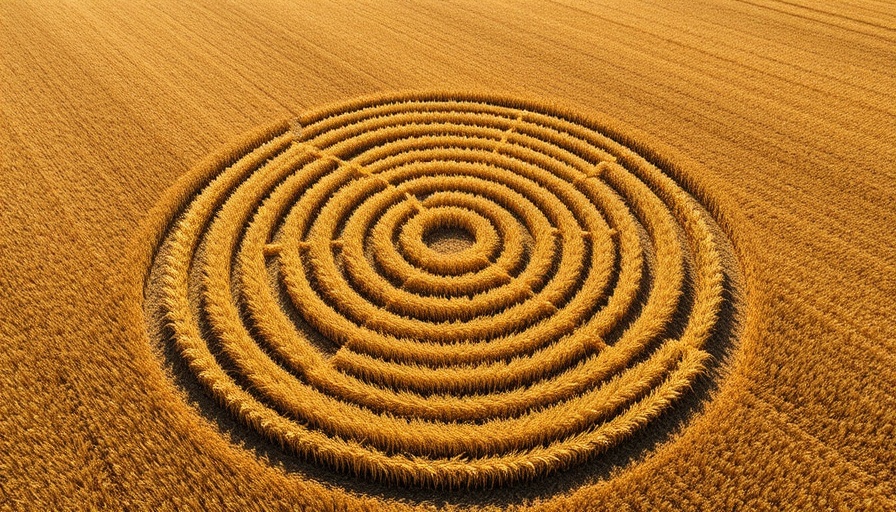
The Mystery of Crop Circles: Separating Fact from Fiction
Crop circles evoke awe and intrigue, often sparking theories that range from extraterrestrial encounters to secret agricultural practices. While they can appear enchanted—geometric patterns orchestrated by unknown forces—the reality behind their creation is much more grounded. This article dives into what crop circles are, their origins, and the science behind these fascinating agricultural phenomena.
What Exactly Are Crop Circles?
Crop circles are flattened sections of agricultural fields, mostly found in grain crops like wheat and barley. They can take on various shapes, including intricate designs beyond simple circles. While these formations can seem unexplainable, especially when viewed from the sky, they have identifiable origins that demystify their existence.
Breaking Down the Historical Context of Crop Circles
The crop circle phenomenon began to gain traction in the 1970s in England when remarkably complex shapes appeared seemingly overnight. These impressions in the fields sparked a wave of fascination fueled by a growing interest in UFO sightings and alien lore. Media outlets across the globe capitalized on this, weaving a tapestry of narratives that suggested otherworldly origins. However, the intrigue took a twist when two Englishmen confessed to creating several famous crop circles with a simple stomp-and-leave technique, showcasing that the truth was less extraterrestrial than many had believed.
Geometric Patterns: Natural vs. Human-Made
Although some may still romanticize the notion of aliens and supernatural creators behind crop circles, the reality often involves human activities and natural phenomena. Several common agricultural practices can lead to the creation of these patterns. Farmers may unintentionally produce strange shapes when cutting hay or corn for silage—where the moisture content affects how crops are harvested. Similarly, drainage systems known as tile lines can create patterns that mimic artistic designs due to varied crop growth levels.
Exploring the Role of Technology in Agriculture
Modern technology also plays a crucial role in the formation of crop patterns. For instance, center pivot irrigation systems—a staple in contemporary farming—utilize circular planting techniques that may initially appear bizarre without context. These systems optimally distribute water from a central point, and when viewed from a higher vantage, the effect looks like an artistically planted field. With advancements in precision agriculture, these technologies continue to evolve, leading to even more unexpected formations.
Lightning Strikes: Nature's Unexpected Artist
Interestingly, natural occurrences like lightning strikes or strong winds serve as additional explanations for certain crop circle formations. As noted by Talon Becker from the University of Illinois Extension, lightning can damage specific sections of a field, leaving behind patches of flattened crops. Similarly, high winds can push mature plants down, creating shapes that might arouse curiosity from above, but ultimately have natural explanations.
The Prankster Factor: Crop Circles as Art
Beyond nature and agriculture, pranking has also played a significant role in crop circle creation. Group efforts around the world have produced deliberate designs as artistic statements or for sheer fun. These instances show how individuals have taken advantage of the sighting craze, contributing to the intrigue surrounding crop circles while highlighting our human propensity for creativity and playfulness.
How Crop Circles Encourage Exploration and Learning
While crop circles may not be the result of alien artistry, they provoke curiosity and interest in different areas, including farming, meteorology, and even societal perceptions of the unexplained. Understanding the true origins invites a deeper appreciation of agricultural practices and natural events, urging observers to question appearances and approach the unknown with a critical but open mind.
Final Thoughts: Engaging with the Mystery
Cultivating curiosity about the world around us can lead to impressive discoveries and insights. Whether you're looking to investigate the latest farming techniques, explore agricultural patterns, or simply enjoy the beauty of nature’s designs, the discussion around crop circles can open numerous doors. So, next time you encounter an unusual design in a field, consider its origins and perhaps embark on your own exploration into the fascinating intersection of agriculture, technology, and art.
Call to Action: Engage with your local farming community to learn more about agricultural practices and their impacts on crop formation. This connection can enhance your appreciation for food production while contributing positively to local agriculture and sustainability efforts.
 Add Row
Add Row  Add
Add 



Write A Comment